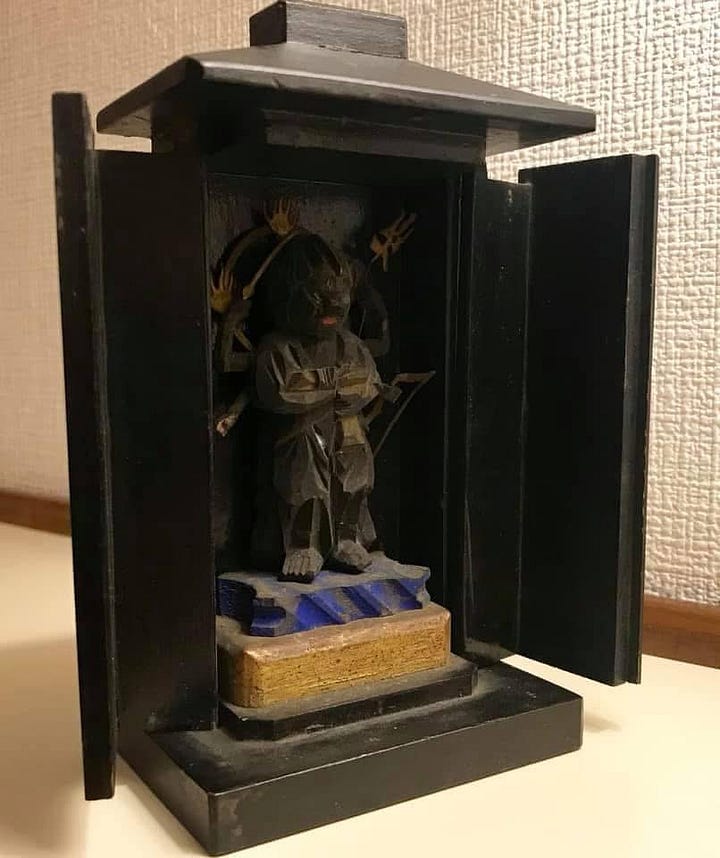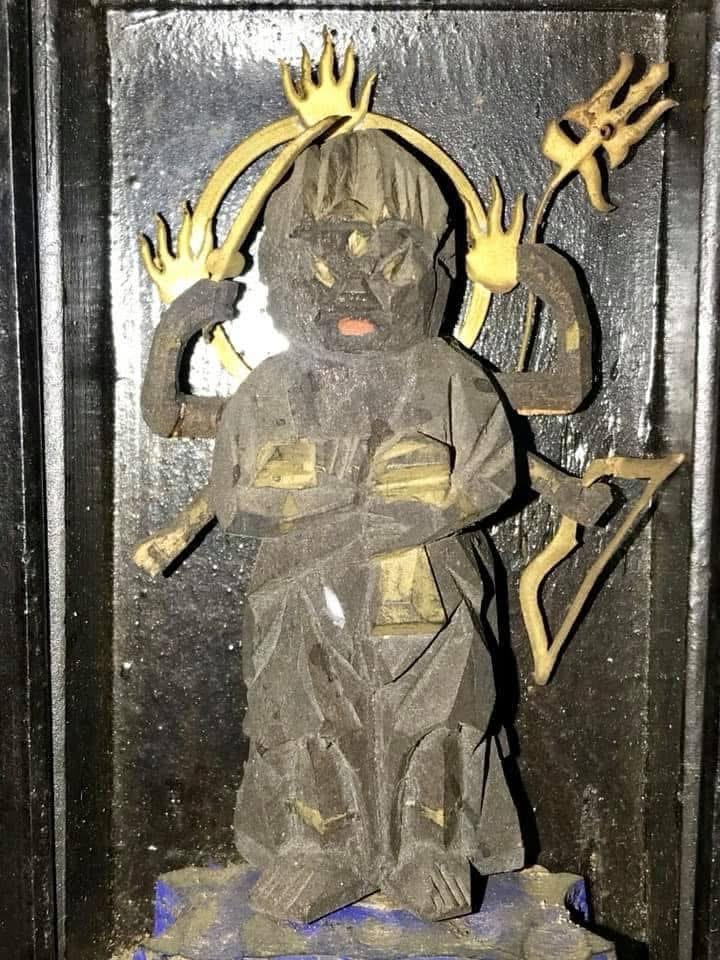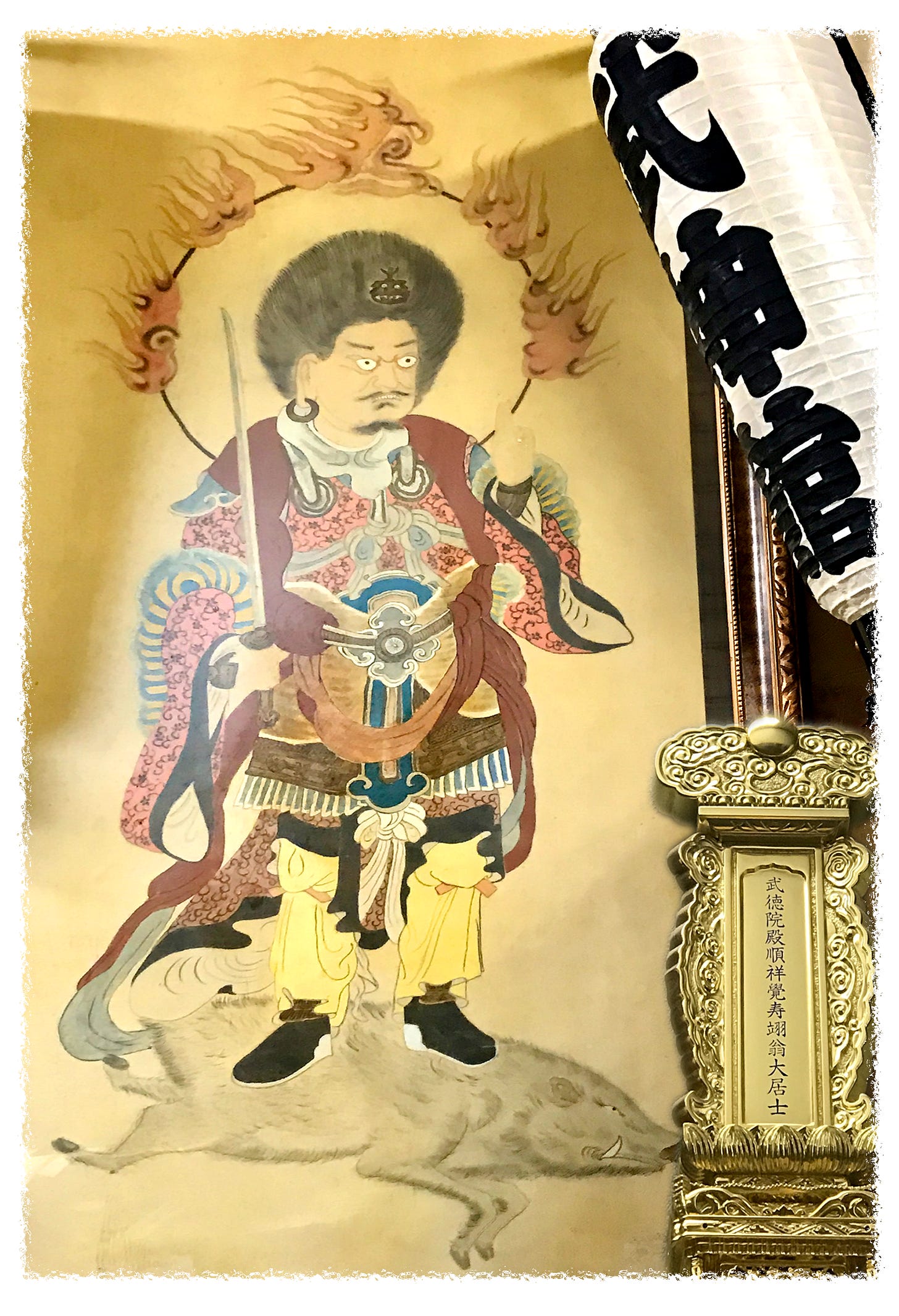Mārīcī (Sanskrit: मारीची), meaning "Ray of Light," is an ancient deity in both Hindu and Buddhist traditions, associated with light, war, and protection. This divinity, known as 摩利支天 in Chinese (Mólìzhītiān) and as 摩利支 in Japanese (Marishiten), holds a significant place in East Asian religious and cultural history. Her influence is particularly notable in Japan, where she is revered as a protector of warriors and martial arts practitioners, especially within Buddhist and traditional Japanese martial contexts.
Origins and history of Mārīcī
Mārīcī’s roots lie in ancient Hindu cosmology, where she is initially portrayed as a personification of the sun's ray or light—a symbol of power, speed, and elusiveness. In Hinduism, Mārīcī is one of the great sages or Rishis, her name literally meaning "ray of light" and representing an enlightened spiritual force. Her figure appears in early Buddhist texts, such as sutras and tantras, where she is associated with enlightenment and protection. In Vajrayana Buddhism, which developed in India and spread across Asia, Mārīcī was adopted as a bodhisattva and later as a protective deity who assists practitioners in overcoming obstacles.
Mārīcī in China: The transformation into Mólìzhītiān
As Buddhism spread to China, Mārīcī was incorporated into the Chinese pantheon as 摩利支天 (Mólìzhītiān). During the Sui (581-618) and Tang (618-907) dynasties, Chinese Buddhism began assimilating various figures from Indian esoteric Buddhism, and Mārīcī took on a role as a protector. She is depicted either riding a boar—a symbol of bravery and strength—or seated on a chariot drawn by seven boars. In Chinese tradition, Mólìzhītiān not only symbolized light and the removal of obstacles but also invisibility and swiftness, qualities that would later resonate with Japanese warriors' strategic practices.
The arrival of Mārīcī in Japan and her adoption in Martial Arts
Mārīcī arrived in Japan through esoteric Buddhism and the transmission of Chinese sutras and tantras during the Asuka period (538-710), when Japan was absorbing and reinterpreting several Buddhist deities. In Japan, she became known as Marishiten (摩利支天) and gained particular importance among samurai warriors and martial arts practitioners. Her influence was especially significant during the Kamakura (1185-1333) and Muromachi (1336-1573) periods, when the professional warrior class, or bushi, was emerging as a powerful force.
Marishiten was adopted as a protective figure, particularly revered within the esoteric practices of the samurai, who prayed to her for invisibility and protection on the battlefield. Invoking Marishiten in times of war symbolized the ability to move undetected—a strategic skill valued in ninjutsu and other martial disciplines. Warriors believed that Marishiten granted special protection, helping them avoid danger and ensuring their safety in combat.

Marishiten’s Iconography in Japan
In Japanese art and iconography, Marishiten is depicted in several forms. In some images, she appears riding a boar, symbolizing her connection to speed and raw power; in others, she is shown with multiple arms, each holding different weapons and esoteric symbols, highlighting her capacity to confront multiple enemies. In her Japanese form, Marishiten often holds a sword and a bow, symbols of martial prowess. Her eyes are sometimes half-closed, representing her introspective nature and connection to meditation and self-awareness—skills essential for martial arts practitioners.
Japanese esoteric Buddhism, which influenced sects like Shingon and Tendai, promoted Marishiten as a spiritual guardian. In Japanese temples, statues and mandalas of Marishiten are found, especially in places frequented by warriors and martial artists, such as Mount Hiei, where both esoteric training and martial disciplines were practiced.
Marishiten’s Influence in Budo and Ninjutsu
Marishiten’s influence on Japanese martial arts is evident in the philosophy of budo and in specific disciplines like ninjutsu. Marishiten inspires concepts of stealth, evasion, and heightened situational awareness. For the ninjutsu practitioner, the ability to move undetected or to "become invisible" is an essential skill, and Marishiten represents this ability on a spiritual level. Ninja and samurai revered Marishiten, seeking her assistance for invisibility, agility, and mental quickness—skills that allowed them to survive and succeed in adversarial situations.
In budo, Marishiten represents a spiritual guide to discipline, self-control, and a refined sense of perception. The deity embodies the light of wisdom that dispels illusions of the ego, enabling the martial artist to focus on the true essence of combat: overcoming fear and finding inner illumination.
The devotion to Marishiten in modern Japan
The veneration of Marishiten has remained alive in Japan, particularly in Buddhist temples dedicated to her. In Tokyo, Zenkō-ji Temple and other shrines have altars for Marishiten, where rituals are held to invoke her protection. Although devotion to Marishiten has decreased with Japan's modernization, festivals and ceremonies are still conducted in her honor, and many martial artists continue to revere her today as a symbol of perseverance, bravery, and protection.
In the contemporary context, Marishiten remains an inspiration in the practice of budo and ninjutsu. Her figure reminds practitioners of the importance of inner calm and mental clarity—qualities essential not only in combat but in all aspects of life.
Mārīcī, or Marishiten in Japan, represents a profound intersection between esoteric Buddhism and martial culture. As a protector of warriors, her presence symbolizes not only the guiding light but also the ability to navigate through shadows and confront battle with a clear mind and serene heart. In modern Japan, while her cult has been overshadowed by other traditions, Marishiten continues to be revered among select groups, particularly by those who understand martial discipline as a path toward self-understanding and inner peace. Thus, the figure of Marishiten transcends time and space, continuing her legacy as a guardian of enlightenment and the art of combat.
Temples and shrines dedicated to Marishiten
In Japan, there are several temples and shrines dedicated to Marishiten, especially in regions where the veneration of this deity has historically been strong among samurai and martial arts practitioners. Some of the most well-known temples include:
1. Zenko-ji (善光寺) – Tokyo.
Located in the Asakusa district of Tokyo, this temple is one of the few with an altar dedicated to Marishiten. It attracts martial arts practitioners and devotees seeking protection and good fortune. Specific rituals are held at Zenko-ji to invoke the protection of Marishiten.2. Choho-ji (長保寺), also known as Marishiten-do – Kyoto.
Situated in Kyoto, this Buddhist temple is popularly known as Marishiten-do due to its dedication to Marishiten. It was a frequented place for samurai seeking protection and skills such as stealth and resilience. The temple still preserves altars and statues dedicated to Marishiten.3. Toyokawa Inari (豊川稲荷) - Toyokawa, Aichi Prefecture.
Although Toyokawa Inari is primarily dedicated to Inari, it also houses a shrine to Marishiten, where prayers for protection and success in matters related to warfare and competition are offered. It is frequently visited by martial arts practitioners and those inspired by the figure of Marishiten.4. Shinsho-ji (新勝寺) - Narita, Chiba Prefecture.
Known as one of Japan’s oldest and most popular temples, Shinsho-ji also holds altars dedicated to Marishiten. This temple is important for esoteric Buddhism and attracts numerous budo practitioners who see Marishiten as a figure of guidance and protection.
These temples have preserved the tradition of venerating Marishiten, offering altars, amulets, and specific rituals to honor her. Although this devotion is not as common in modern Japan, her presence in these temples demonstrates Marishiten’s lasting influence on the spirituality of martial arts and Japanese esoteric Buddhism.


The oldest statues of Marishiten in Japan
The oldest image of Marishiten in Japan is found at Choho-ji (長保寺), also known as Marishiten-dō, in Kyoto. This temple is recognized as one of the first places in Japan to establish an altar specifically dedicated to Marishiten, linked to warrior protection practices and esoteric traditions.
The statue of Marishiten at Choho-ji, dating from the Heian period (794-1185), is considered one of Japan’s earliest representations of this deity. It depicts Marishiten in a majestic and protective posture, often with attributes such as the boar and multiple arms holding symbols of protection and power. This image reflects Marishiten's transition from her origins in esoteric Buddhism to becoming a protective deity for samurai and martial arts practitioners in Japan.
Another notable ancient representation of Marishiten is found at Zenkō-ji in Tokyo, although it is more recent compared to that of Choho-ji. These ancient images of Marishiten are valued not only as works of art but also as symbols of the profound spiritual connection that Japanese warriors developed with this deity in their quest for protection, strength, and wisdom on the battlefield.
Prayer and invocation to Marishiten
To invoke Marishiten, practitioners in Japan and within the esoteric Buddhist tradition use a combination of mantras, mudras (ritual gestures), and specific prayers. These rituals aim to receive the protection, invisibility, speed, and mental clarity that Marishiten symbolizes. Here are some common elements in invoking her presence:
1. Mantra of Marishiten
The mantra is a sacred formula that, when recited, establishes a spiritual connection with Marishiten. A commonly used mantra for invoking her protection is:
Om Marici svaha (ओं मारीचि स्वाहा)
This mantra is chanted repetitively, focusing on the intent to summon Marishiten’s protection and clarity. In the martial context, it’s recited to seek invisibility and swiftness in movement, essential qualities on the battlefield.
2. Mudra of Marishiten
The mudra associated with Marishiten is the Marishi-in (摩利支印), a specific hand gesture representing her protective energy. The practitioner places their hands in front of their chest, with the index and ring fingers raised while the thumb holds the other fingers in a symbol of strength and determination. This mudra is combined with the mantra recitation to concentrate and channel Marishiten’s protective energy.
3. Prayer and invocation to Marishiten
In temples and esoteric practices, specific prayers are recited to seek Marishiten’s protection and favor. A typical prayer might be:
摩利支天よ、武士たちの守護者、輝く光の光線よ、私にあなたの力と庇護を授けてください。あなたが象徴する光のように、見えないままに、俊敏で速く動けるようにしてください。私の道において、明晰さと決意を授けてください。
Marishiten yo, bushi-tachi no shugosha, kagayaku hikari no kosen yo, watashi ni anata no chikara to higo o sazukete kudasai. Anata ga shouchou suru hikari no you ni, mienai mama ni, shunbin de hayaku ugokeru you ni shite kudasai. Watashi no michi ni oite, meiseki-sa to ketsui o sazukete kudasai.
"Marishiten, protector of warriors, radiant ray of light, grant me your strength and refuge. Allow me to move unseen, agile and swift like the light you embody. Grant me clarity and resolve on my path."
This prayer is recited at the beginning of the ritual and can be incorporated into meditation, visualizing Marishiten as an enveloping light of protection.
In Japanese and Chinese esoteric traditions, there are some sutras and mantras dedicated to Marishiten, though it’s important to note that her invocation tends to be brief and focused on mantras rather than lengthy prayers, especially in esoteric Buddhism. One of the most well-known texts related to Marishiten is the Marici Dharani (摩利支天陀羅尼), a sacred invocation or "dharani" used to request her protection and abilities.
This is one of the short prayers traditionally used in her veneration:
摩利支天真言 (Marici Ten Shingon):
On Marishi Sowa Ka (オン・マリシ・ソワカ)
This mantra, which roughly translates to "Oh, Marici, bless me," is a direct call to Marishiten for her protection and power. "On" is a syllable that opens many Buddhist mantras, symbolizing respect and devotion; "Marishi" is her name; and "Sowa Ka" is a closing phrase meaning something akin to "so be it" or "may it be fulfilled."
In the Japanese esoteric context, practitioners may accompany this mantra with specific visualizations and mudras, repeating it in series to create a spiritual atmosphere that fosters connection with Marishiten and invites her favor.
4. Visualization
Along with the mantra, mudra, and prayer, practitioners often perform a visualization during the ritual. Marishiten is imagined as a radiant figure, riding a boar or in a chariot drawn by seven boars, surrounded by a light representing protection and speed. The practitioner visualizes this light surrounding their body, making them invisible and shielding them from harm.
5. Performing the ritual
This ritual can be done in temples or private practice. The complete sequence involves chanting the mantra repetitively, using the mudra, visualizing Marishiten, and reciting the prayer. These steps help cultivate a connection with Marishiten and gain her favor for protection and success in martial arts or any situation requiring clarity and spiritual strength.
In some temples, monks perform this ritual specifically for martial arts practitioners seeking Marishiten’s blessing, particularly in places where martial tradition is strong, such as Chōhō-ji Temple in Kyoto.

The warrior class’s devotion to Marishiten
There is a documented tradition of various Japanese warriors, especially among the samurai, venerating Marishiten to seek protection and qualities like invisibility and swiftness in combat. One of the most notable examples is Uesugi Kenshin (1530–1578), a famous daimyō of the Sengoku period and one of Japan’s most revered generals. Uesugi Kenshin was known for his deep devotion to Buddhism and his connection with Marishiten, whom he regarded as a spiritual protector on the battlefield.
Uesugi Kenshin and his devotion to Marishiten
Uesugi Kenshin, also called "the Dragon of Echigo" for his martial skill and indomitable character, was famous for performing esoteric Buddhist rituals before going into battle. Although his primary deity was Bishamonten, the Buddhist god of war and protector of warriors, he was also said to venerate Marishiten, especially to obtain invisibility and agility—qualities essential in military strategy.
For Kenshin, Marishiten represented the power to move undetected and quickly, crucial qualities for launching surprise attacks and evading enemies. Records of his combat strategies show that he employed tactics relying on speed and the element of surprise, attributes that, in a spiritual context, are associated with Marishiten's influence.
The influence of Marishiten on Ninja clans
In addition to samurai, some ninja clans were also influenced by devotion to Marishiten. Although there are no specific records of individual ninjas in this regard, texts on ninjutsu and oral traditions from clans such as the Iga clan mention the practice of invoking Marishiten to enhance invisibility and stealth skills. In the philosophy of ninjutsu, the power to "be invisible" or move undetected was seen as both a physical and spiritual skill, and Marishiten was one of the deities embodying this ability.
While mentions of Marishiten among warriors and ninjas are not as frequent in detailed historical records, she was clearly venerated as a source of protection and valuable strategic qualities. In the case of Uesugi Kenshin, his connection with Marishiten, combined with his faith in Bishamonten, demonstrates how warriors of the Sengoku period sought guidance from Buddhist deities to complement their combat skills.





